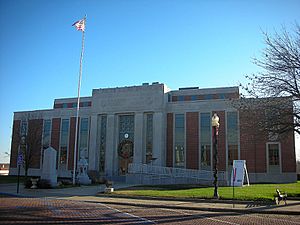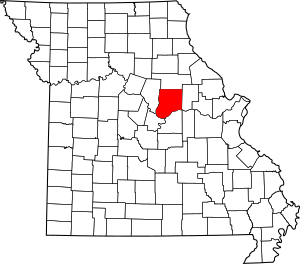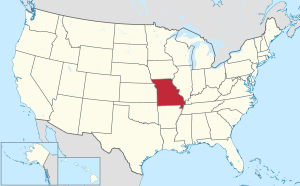Callaway County, Missouri facts for kids
Quick facts for kids
Callaway County
|
|
|---|---|

The Callaway County Courthouse in Fulton
|
|

Location within the U.S. state of Missouri
|
|
 Missouri's location within the U.S. |
|
| Country | |
| State | |
| Founded | November 25, 1820 |
| Named for | James Callaway |
| Seat | Fulton |
| Largest city | Fulton |
| Area | |
| • Total | 847 sq mi (2,190 km2) |
| • Land | 835 sq mi (2,160 km2) |
| • Water | 13 sq mi (30 km2) 1.5% |
| Population
(2020)
|
|
| • Total | 44,283 |
| • Density | 52.282/sq mi (20.186/km2) |
| Time zone | UTC−6 (Central) |
| • Summer (DST) | UTC−5 (CDT) |
| Congressional district | 3rd |
Callaway County is a county located in the U.S. state of Missouri. As of the 2020 United States Census, the county's population was 44,283. Its county seat is Fulton. With a border formed by the Missouri River, the county was organized November 25, 1820, and named for Captain James Callaway, grandson of Daniel Boone. The county has been historically referred to as "The Kingdom of Callaway" after an incident in which some residents confronted Union troops during the U.S. Civil War.
Callaway County is part of the Jefferson City, Missouri, Metropolitan Statistical Area.
Vineyards and wineries were first established in the area by German immigrants in the mid-19th century. Among the first mentioned in county histories are those around the southeastern Callaway settlement of Heilburn, a community neighboring Portland, on the Missouri River. Since the 1960s, there has been a revival of winemaking there and throughout Missouri.
The Callaway Nuclear Generating Station is located in Callaway County, near Fulton.
Contents
History
This area was historically occupied by the Osage and other Native American peoples, some of whom migrated from the east of the Ohio River Valley. Others emerged as cultures in this area, following thousands of years of settlement by indigenous peoples.
The European-American settlement of Callaway County was initiated primarily by migrants from the Upper South states of Kentucky, Tennessee and Virginia. They brought African-American slaves and slaveholding traditions with them, and quickly started cultivating hemp and tobacco, the same crops as were grown in Middle Tennessee and Kentucky. Callaway County was one of several to the north and south of the Missouri River settled mostly by Southerners in the early antebellum years. Given their culture and traditions, this area became known as Little Dixie, and Callaway was at its heart. In 1860 slaves made up 25 percent or more of the county's population, a higher percentage than in most parts of the state. Residents generally supported the Confederacy during the Civil War. The Battle of Moore's Mill was the only significant Civil War battle that occurred in Callaway County. From the Civil War era the county earned the nickname of the Kingdom of Callaway.
Other settlers in the Missouri River valley included German immigrants from the mid-19th century following the Revolutions of 1848 in the German states; they established a strong wine industry in the area and built towns with German-influenced architecture. Missouri was the second-largest wine-producing state nationally until Prohibition. Since the 1960s, numerous vineyards and wineries have been established again in the valley, including Summit Lake Winery in Holts Summit. The county is part of what is called the Missouri Rhineland, an area of vineyards along both sides of the Missouri River extending from St. Charles County west to Callaway County.
Geography
According to the U.S. Census Bureau, the county has a total area of 847 square miles (2,190 km2), of which 835 square miles (2,160 km2) is land and 13 square miles (34 km2) (1.5%) is water.
Callaway County lies on the border of transition between prairie and rugged Ozarks. The northern part of the county is relatively flat and devoid of large tracts of forests. The southern border of the county is the Missouri River, and the area is heavily forested over large hills and valleys. Cedar Creek makes up the northern part of the western border.
Adjacent counties
- Audrain County (north)
- Montgomery County (east)
- Osage County (south)
- Cole County (southwest)
- Boone County (west)
- Gasconade County (southeast)
Major highways
 Interstate 70
Interstate 70 U.S. Route 40
U.S. Route 40 U.S. Route 54
U.S. Route 54 U.S. Route 63
U.S. Route 63 Route 94
Route 94
National protected areas
Demographics
| Historical population | |||
|---|---|---|---|
| Census | Pop. | %± | |
| 1830 | 6,159 | — | |
| 1840 | 11,765 | 91.0% | |
| 1850 | 13,827 | 17.5% | |
| 1860 | 17,449 | 26.2% | |
| 1870 | 19,202 | 10.0% | |
| 1880 | 23,670 | 23.3% | |
| 1890 | 25,131 | 6.2% | |
| 1900 | 25,984 | 3.4% | |
| 1910 | 24,400 | −6.1% | |
| 1920 | 23,007 | −5.7% | |
| 1930 | 19,923 | −13.4% | |
| 1940 | 23,094 | 15.9% | |
| 1950 | 23,316 | 1.0% | |
| 1960 | 23,858 | 2.3% | |
| 1970 | 25,850 | 8.3% | |
| 1980 | 32,252 | 24.8% | |
| 1990 | 32,809 | 1.7% | |
| 2000 | 40,766 | 24.3% | |
| 2010 | 44,332 | 8.7% | |
| 2020 | 44,283 | −0.1% | |
| U.S. Decennial Census 1790-1960 1900-1990 1990-2000 2010-2020 |
|||
As of the census of 2000, there were 40,766 people, 14,416 households, and 10,336 families residing in the county. The population density was 49 people per square mile (19/km2). There were 16,167 housing units at an average density of 19 per square mile (7/km2). The racial makeup of the county was self-identified as 91.79% White, 5.66% Black or African American, 0.52% Native American, 0.52% Asian, 0.01% Pacific Islander, 0.30% from other races, and 1.21% from two or more races. Approximately 0.92% of the population identified as Hispanic or Latino of any race. 29.9% identified as of German ancestry, 22.0% as American, 9.1% as Irish (including Scots-Irish) and 9.1% as English ancestry.
There were 14,416 households, out of which 35.80% had children under the age of 18 living with them, 57.10% were married couples living together, 10.40% had a female householder with no husband present, and 28.30% were non-families. 23.00% of all households were made up of individuals, and 8.80% had someone living alone who was 65 years of age or older. The average household size was 2.56 and the average family size was 3.00.
In the county, the population was spread out, with 25.40% under the age of 18, 11.10% from 18 to 24, 31.00% from 25 to 44, 21.50% from 45 to 64, and 11.00% who were 65 years of age or older. The median age was 35 years. For every 100 females, there were 107.60 males. For every 100 females age 18 and over, there were 108.90 males.
The median income for a household in the county was $39,110, and the median income for a family was $44,474. Males had a median income of $29,574 versus $22,317 for females. The per capita income for the county was $17,005. About 6.00% of families and 8.50% of the population were below the poverty line, including 10.30% of those under age 18 and 8.30% of those age 65 or over.
Religion
According to the Association of Religion Data Archives County Membership Report (2010), Callaway County is sometimes regarded as being on the northern edge of the Bible Belt, with evangelical Protestantism being the most predominant religion. The most predominant denominations among residents in Callaway County who adhere to a religion are Southern Baptists (41.60%), Roman Catholics (14.00%), and United Methodists (9.41%).
Communities
Cities
- Auxvasse
- Fulton (county seat)
- Holts Summit
- Jefferson City (mostly in Cole County)
- Mokane
- New Bloomfield
Villages
Unincorporated communities
Townships
- Auxvasse
- Bourbon
- Caldwell
- Calwood
- Cedar
- Cleveland
- Cote Sans Dessein
- East Fulton
- Guthrie
- Jackson
- Liberty
- McCredie
- Nine Mile Prairie
- Round Prairie
- St. Aubert
- Shamrock
- Summit
- West Fulton
Education
Public schools
-
- McIntire Elementary School (PK-05)
- Bush Elementary School (K-05)
- Bartley Elementary School (K-05)
- Fulton Middle School (06-08)
- Fulton High School (09-12)
- Stark Elementary School (K-05)
- Wheeler Middle School (06-08)
- Wheeler High School (09-12)
- New Bloomfield Elementary School (PK-06)
- New Bloomfield High School (07-12)
- Auxvasse Elementary School (PK-08) – Auxvasse
- Hatton-McCredie Elementary School (K-08)
- Williamsburg Elementary School (K-08)
- North Callaway County High School (09-12)
- South Callaway County Early Childhood Education Center (PK-02)
- South Callaway County Elementary School (03-05)
- South Callaway County Middle School (06-08)
- South Callaway County High School (09-12)
Private schools
- Shepherdsfield School – Fulton (K-12) – Nondenominational Christian
Post-secondary
- Westminster College - Fulton - A private, four-year Presbyterian university.
- William Woods University - Fulton - A private, four-year university.
Public libraries
Notable people
- William F. Baker, structural engineer for the Burj Khalifa
- Morris Frederick Bell, architect
- Nick Cave, fabric sculptor, dancer, and performance artist
- Henry Bellamann, poet and author of Kings Row
- John Ferrugia, journalist
- Tony Galbreath, running back in the NFL for the New Orleans Saints (1976–1980), the Minnesota Vikings (1981–1983), and the New York Giants (1984–1987)
- William Lincoln Garver, architect, author, and socialist politician
- Charlie James, Major League Baseball outfielder for the St. Louis Cardinals (1960–1965)
- John Jameson, U.S. Representative from Missouri (1839-1841, 1843-1845, 1847-1849)
- Michael Kim, ESPN anchor and personality
- Bake McBride, Major League Baseball outfielder and 1974 National League Rookie of the Year
- Ron McBride, running back in the National Football League for the Green Bay Packers 1973
- Laura Redden Searing, also known as Howard Glyndon, deaf poet and writer
- Justin Smith, former NFL player
- Helen Stephens, 1936 Olympic Champion (The Fulton Flash)
See also
 In Spanish: Condado de Callaway para niños
In Spanish: Condado de Callaway para niños

